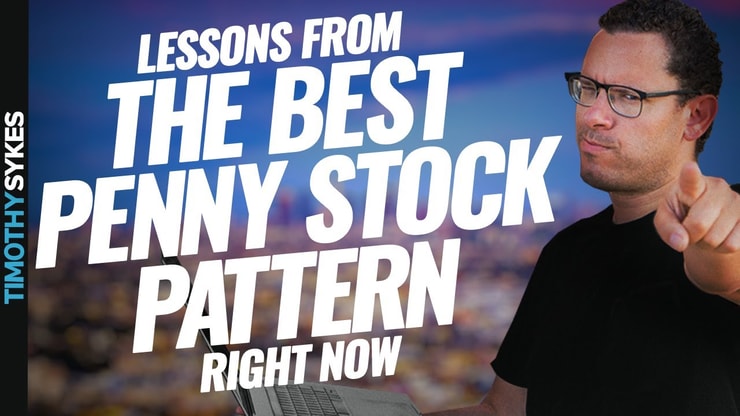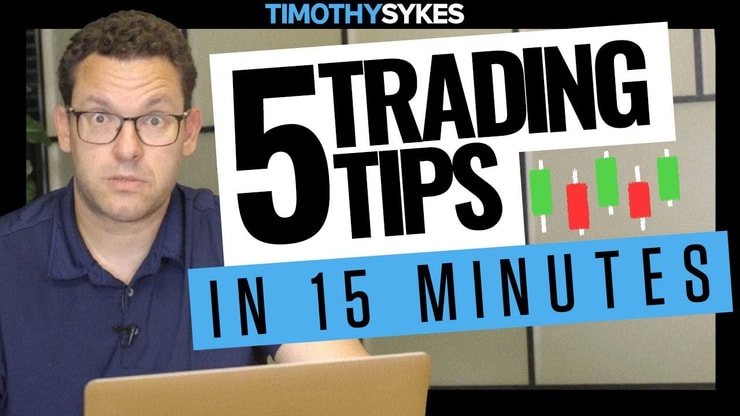Let’s talk about day trading fundamentals for beginners. Day trading is one of the most misunderstood trading styles. Get straight before you head into the market.
Now, when you think of day trading, what comes to mind?
A lot of people think of scammers like they see in “The Wolf of Wall Street.” Sure, that movie is based on a true story … but it really doesn’t represent the reality of being a day trader.
Day trading is a legitimate career choice … if you approach it intelligently.
Ready to explore this niche? Read on to find out how to get started day trading. You’ll learn what it is, how it works, and how to avoid common mistakes I see people make all the time.
Table of Contents
- 1 Day Trading Fundamentals: What Is Day Trading?
- 2 How Does Day Trading Work?
- 3 How to Start Day Trading Stocks in 2024
- 4 Simple Day Trading Tips and Strategies for Beginners
- 5 The Top Broker for Day Trading
- 6 Day Trading for Beginners: Top Computers and Software
- 7 Day Trading for a Living … Is It Possible?
- 8 What Kind of Stocks Should I Day Trade?
- 9 When to Sell Stocks to Be a Successful Day Trader
- 10 Basic Day Trading Strategies
- 11 Day Trading Fundamentals Rules
- 12 Day Trading Taxes
- 13 Trading Challenge
- 14 The 4 Top Day Trading Books for Beginners
- 15 Conclusion: Is Day Trading For You?
- 16 Frequently Asked Questions About Day Trading for Beginners
- 16.1 Is Day Trading Still Profitable?
- 16.2 How Much Do You Need for Day Trading as a Beginner?
- 16.3 How Much Do Day Traders Make a Day?
- 16.4 Can You Day Trade With $1,000 Dollars?
- 16.5 Can You Start Day Trading With $100?
- 16.6 How Can You Limit Losses When Day Trading?
- 16.7 What Makes Day Trading Difficult?
- 16.8 Is Pattern Day Trading Illegal?
Day Trading Fundamentals: What Is Day Trading?
The definition of day trading is buying and selling shares of a stock within a single trading day. So between the time the market opens and closes, you open and close your position.
This doesn’t mean that if you ever hold positions overnight you’re no longer a day trader. That does happen. But the strictest definition of a day trader is one who holds positions for a day or less.
For this article, I’ll stick with that definition. And generally, the stocks I refer to are penny stocks — stocks priced under $5 per share — because that’s what I trade.
How Does Day Trading Work?
The goal of day trading is similar to just about any other method of trading or investing: to earn a profit. But how you actually approach that goal is a little different with day trading.
For instance, if you buy shares of a blue-chip stock, you’re basically committing to a long-term relationship. This is a company you believe in — or at least you believe its stock will increase in value.
Day trading is a lot more like a one-night stand. You don’t buy a company’s stock because you believe this company has what it takes … and you don’t intend to stick around for long.
You choose stocks based on price action. The stock could be going up for a variety of reasons — big news, a shiny new contract, or a hot new product. You hope to take advantage of short-term price fluctuations.
How to Start Day Trading Stocks in 2024

What’s necessary to actually execute day trades? That’s pretty easy…
You’ll need a brokerage account to execute trades and trading software to help you find and track stocks. Often, these two things are combined into one program to work seamlessly.
How to Select Stocks for Day Trading
There are thousands of stocks to choose from … so how do you find the “right” stocks?
It all starts with building and maintaining a watchlist. That’s a list of stocks that you’re tracking.
A stock screener is an invaluable tool for helping you make and maintain this list. Plus you can use your screener to filter stocks based on criteria that you set.
For instance, maybe you’re looking for big percent gainers or stocks with an upcoming earnings announcement. Every trader has specific preferences. A screener can help you filter and focus on what works for you.
Day Trading Fundamentals Tips for Trading Penny Stocks as a Beginner
Day trading can be daunting for a beginner. Especially penny stocks — they’re volatile and can have huge price fluctuations.
But learning how to day trade, recognize patterns, and become a self-sufficient trader can be empowering.
The key thing for day trading beginners to remember is to take it slow. It’s a marathon, not a sprint. Take the time to learn the basics and understand price action before you take a trade.
I recommend new traders start with paper trading to get a feel for trading and the markets.
Simple Day Trading Tips and Strategies for Beginners
The following simple stock trading strategies are what I teach all my students. They’re also what I practice.
More Breaking News
- Top Bitcoin Stocks to Watch Under “Crypto Emperor Trump”
- BigBear.ai’s Journey in the Stock Market: Rising Trends and Challenges
Tip #1: Don’t Use Leverage
Leverage lets you borrow shares from your broker to increase your position size. The idea is that by taking a bigger position, you could make much bigger profits.
The problem? You can really get yourself in the hole this way, too. Leverage is the ruin of most traders, especially newbies. You don’t need to use leverage. Don’t do it.
If you lose, pretty soon you’ll get the dreaded call from the broker asking you to deposit more money to cover your losses.
If you can’t cover your losses, it could be game over. Not worth it.
Tip #2: Follow Stock Chart Patterns
When you start to really look at the price action of penny stocks, you’ll see that they move in patterns. These patterns can create opportunities for traders.
How? Well, over time, patterns repeat. If you really study, you can learn patterns, understand how to recognize them, and know when it’s time to pounce. At first, you should learn a few patterns and get good at spotting them.
In my free penny stock guide, I cover some stock chart pattern basics. Want more? Check this out.
Tip #3: Create Your Own Stock Portfolio
‘Stock portfolio’ sounds awfully serious, but don’t be intimidated. This just refers to the different stocks that you trade and the positions you hold.
With any type of portfolio, it’s important to make your own decisions about the securities you choose. Yes, it’s fine to get information from a number of sources. But ultimately, you’re the one responsible for the trade. So do your research.
Additionally, be sure to curate a diverse portfolio. Things change FAST in the stock market, so you never want to put all your eggs in one basket.
Want more? Check out my infographic on how to build a stock portfolio.
Tip #4: Trade Volatile Stocks
Volatility isn’t a trait you might look for in a romantic partner or best friend. But in terms of stocks, volatility is your friend.
Volatility is a measure of a stock’s price movement over time. When you study charts, you’re looking for price movement patterns.
High volatility is what you see when there’s a lot of up and down. If there’s no movement, you can’t make a profit.
Day trading for a living means embracing volatility. Volatility is also good for the overall market, even for buy-and-hold investors. At some point, most investors want to sell their shares, right? Without volatility and trading volume, it’s difficult to sell.
Tip #5: Use Mental Stops
Mental stops are one of my personal day trading secrets. A mental stop differs from a physical stop — you don’t set a stop with trading software. Instead, you’re pinky-swearing to yourself that you’ll enter and exit a trade at the points you set.
One way to do this is to focus on the risk-reward ratio.
For example, imagine you have a play on a $4 stock. Your target upside is $1 per share. You might choose to cut your losses at 25 cents per share. That makes your risk/reward ratio 4:1. You want to see risk-reward ratios of at least 3:1 or 4:1. Anything lower — like 1:1 or 2:1 — and there’s just not enough in it for you.
By using mental stops, you can still take advantage of the liquidity of penny stocks but with lower risk. Here’s the key: once the trade hits your mental stop criteria, get out. Close the position.
Some people ridicule me because sometimes I close out positions too soon and don’t make as much profit. Guess what? I don’t care. I’m still profiting, even if it’s small.
Tip #6: Never Stop Learning
When you think you know it all, your trading career is doomed.
The market has an uncanny way of knowing when you’re cocky. It can humble you all too fast. All it takes is a little change.
You must learn to adapt as a trader, and that means that you can never stop learning. There’s value in every experience. My biggest losses have been some of my biggest teachers … so have some of my biggest wins.
But how can you actually learn from them? Keep a trading journal.
This is where you note things like your entry and exit points, what you did right, what you did wrong, and how you could do it differently. It can help you reduce mistakes and streamline what’s working.

Tip #7: Set Aside Funds
Never trade more than you can afford to lose. In this video, my student Michael Goode talks about how he started out investing all his profits into the next trade. That’s a great way to grow your account … or blow up your account.
Don’t take the risk. Whenever you profit, save some of those proceeds. Don’t just reinvest everything.
Tip #8: Start Small
Scale up over time. Instead of going all in every time, start with small amounts. You gotta learn what works and what doesn’t in a trade.
Then, and only then, should you start scaling up the amount of money you risk.
Remember: even if you don’t make tons of real money in your brokerage account, your education account is growing. Knowledge will serve you most as a trader.
Tip #9: Manage Your Risk
This is one of the most important and simplest lessons I can teach you. It’s also one of the biggest lessons that new traders ignore.
Day trading comes with risk. Penny stocks come with risk. But you don’t have to love risk to day trade penny stocks. In fact, I’d prefer you didn’t love risk. I don’t, and I think it’s one of my keys to staying in the game this long.
As a trader, I want to do everything I possibly can to reduce my risk: setting specific goals, having a plan, doing the research, and being disciplined about my mental stops.
If the price action reaches where I said I’d take profits, I do. The stock might go higher — that’s OK. I’m fine with a smaller win if I stay safe.
But managing risk also means cutting losses quickly. If a trade doesn’t go your way, don’t wait around. Cut your losses, learn from the experience, and move on.
The Top Broker for Day Trading
You need a broker to execute trades, but which broker should you choose?
Choosing a broker is a personal decision. It depends on your opening balance, the features you need, your location — a number of factors.
Every broker has its advantages and disadvantages.
I will say this: DON’T just go for the cheapest broker or the first one you find. Do your research. You should be comfortable with all the tools you use, including your broker. They should be an asset to your trading venture.
This organization will handle your account and your trades. Make sure they execute trades quickly and reliably and don’t have a ton of hidden fees. You don’t want someone shady handling your money.
The Top Day Trading Platform for Beginners
If you ask me, StocksToTrade is the best day trading platform, hands down. It’s a trading platform and stock screener all in one.
Full disclosure: I helped create the StocksToTrade platform and I’m an investor in it. Here’s why … I wanted to help create a platform that’s built for the way I trade and teach.
The StocksToTrade team worked hard to get this platform up and running. It has built-in scans, killer charts, news feeds, and much more. And now you can add on the all-new Breaking News Chat feature.
It also has a great paper trading (virtual trading) module, which is a great tool for day trading for beginners. This is how you can test out different strategies without actually risking real money.
If you think of the stock market as a battlefield, StocksToTrade is like having the best weapon.
Day Trading for Beginners: Top Computers and Software

In terms of software, all you really need is your online brokerage account, stable Wi-Fi, and a stock screener. We already covered those, but what kind of computer should you use?
Once again, this is a totally personal decision. Some traders prefer to trade on a bigger monitor or even multiple monitors.
Since everyone wants to know — I use a MacBook Pro. As I’ve shared on YouTube, I own a few laptops but do most of my trading from just one. But I always have a backup … just in case.
Looking for computer guidance? I outline some key points in this post.
How Many Stocks Should I Trade Per Day as a Beginner?
When we’re talking about day trading for beginners, we gotta talk about the pattern day trader (PDT) rule. The PDT limits how many trades many beginners can execute within specific time periods.
It specifically limits traders who have less than $25,000 in their accounts. So, if your account is under this amount, you can only make three day trades in a five-day period.
That doesn’t mean you’re limited to three trades per week, period. You can hold as many overnight positions as you want.
But when you’re new to the market, two or three good trades a week is all you need. Yes, it takes time to build an account this way, but it’s time well spent as you learn the smart way to trade. Those singles add up!
Day Trading for a Living … Is It Possible?
Is day trading for a living possible? Short answer: yes. But wait! The longer answer is that you shouldn’t count on it to happen quickly or assume that it will happen at all.
Most traders fail. I think that’s because people are too lazy. They want too much too fast. So many traders don’t take the time to learn how the stock market actually works before they start trading.
What Kind of Stocks Should I Day Trade?
Day trading isn’t limited to a specific price point or sector. However, the method that’s helped me find success — and what I teach my students — is day trading penny stocks.
Here are two of the biggest reasons that penny stocks can be great for day trading for beginners…
First, they’re low priced. This makes them accessible to traders who have small accounts.
Second, they’re volatile. The volatility with penny stocks means it’s possible to experience huge gains in small periods of time … This makes it possible to grow a small account faster than with blue-chip stocks or more traditional investments.
When to Sell Stocks to Be a Successful Day Trader
When should you sell stocks? Ultimately, you’ve got to learn to make that choice for yourself.
As a day trader, you should ALWAYS make a trading plan. You need to know when to sell the stock — either to take profits or cut losses. Remember to set reasonable goals. Don’t get greedy.
As for losses … My #1 rule for day trading is that you MUST cut losses quickly. So if a trade doesn’t go your way, it’s time to sell. Just get out. Learn the discipline to stick to your plan.
Need help figuring out how to make a trading plan? Check out this post.
Basic Day Trading Strategies
Everyone has a unique trading style. There are a ton of different strategies and approaches to day trading. Here are just a few you should know about.
These styles aren’t all completely independent. For instance, it’s possible to be a trend-following trader who uses ranges or a scalper who follows the news and price action.
Trend Following
Trends are everywhere, even the stock market. In terms of stocks, certain sectors might heat up due to things like increased news coverage or legislation changes (think weed legalization or the coronavirus pandemic).
Trend-following traders try to identify trends ahead of the curve or during dips, then try to ride the momentum.
Contrarian Investing
This means going against the flow. For instance, if you believe a stock is pumped up, you might attempt to short sell, anticipating that it will go down in value.
Range Trading
With range trading, you rely on support and resistance to set buy and sell points.
Scalping
Scalping refers to a day trading method where a trader makes frequent trades, hoping to make money through multiple tiny gains. It’s often based on quantity rather than quality. I don’t suggest this method for new traders.
Rebate Trading
This is a style of trading where you short sell right from an ECN (electronic communications network) to get a rebate for the transaction. Really, it’s trying to game the rebate system for profits. Not my thing.
Playing the News
News moves stocks! If you’re playing the news, you’re looking for opportunities based on increased volume and volatility of a stock related to news or press releases.
Price Action
With this style of trading, you’re looking specifically for a stock’s price movement. This means looking for big percent gainers and making trading decisions based on price movements rather than looking at the fundamentals.
Artificial Intelligence/Algorithmic Trading
Robo-trading! Also referred to as algorithmic trading, this style of trading relies on algorithms. AI programs can actually execute trades for you based on criteria you set. I prefer to execute all my trades and be in on the action.
Day Trading Fundamentals Rules
Discipline is crucial for day trading — especially for beginners — but really for traders of all levels.
I have rules for day trading that I follow as a day trader … And usually, when I mess up it’s because I broke my own rules.
Don’t think that you can jump ahead of the line. Be diligent, work hard, and follow the rules. Ready to learn? Here are my most vital trading rules.
Day Trading Taxes
For day traders, taxes can be more complicated than just punching the entries from a W-2 into an online tax platform.
This is important: short-term investments or positions of less than a year are taxed at a different rate than long-term investments.
The U.S. tax system is tiered based on your income and the amount you’ll have to pay will vary. Always consult a professional licensed before making tax or legal decisions.
For more detail on trading and taxes, see this post.
Trading Challenge
My Trading Challenge is set up to help you speed up your trading learning curve. It’s a comprehensive training program that can help you become a disciplined, self-sufficient trader. But it’s not just for anyone.
You’ve got to apply for the Challenge. I won’t let just anyone in … especially people who think they’ll get rich quick. You have to be willing to work for it.
In the Challenge, you’ll have access to thousands of videos, DVDs, webinars, and plenty of other learning tools. You’ll also have access to an engaged community of like-minded traders who are learning and motivated, just like you.
This is the resource I wish I had when I was starting out as a trader … and it’s my way of helping others reach their potential.
The 4 Top Day Trading Books for Beginners

“The Complete Penny Stock Course”
The “Complete Penny Stock Course” was written by my student Jamil. He organized all my lessons into this complete course on penny stock trading. Get your copy here. Or you can get it as a bonus when you sign up for my 30-Day Bootcamp.
“Japanese Candlestick Charting Techniques”
This book is a great resource for learning about technical analysis. You can purchase it here. Also, check out Steve Nison’s other book “The Candlestick Course.”
“Reminiscence of a Stock Operator”
This book is a classic. It’s a great story loosely based on the career of Jesse Livermore. It goes into trading psychology, speculating, and the nature of the market. You can find it here online or in your local bookstore.
(As an Amazon Associate, we earn from qualifying purchases.)
“An American Hedge Fund”
And, of course, there’s my best-selling book, “An American Hedge Fund.” Get your copy for no cost to learn how I found my own way in the markets, why cutting losses is my number-one rule, and why I trade like I’m retired. Get your zero-cost copy here.
Conclusion: Is Day Trading For You?
The first step to becoming a day trader? Getting educated on what day trading actually is and how it works. You’ve taken that step here … does it interest you?
And yeah, it’s easy to get started as a day trader, but that doesn’t mean it’s easy to be a day trader. It requires meticulous planning, loads of research, and plenty of time studying stock charts, stocks, and news.
There are plenty of resources on my site, like my free online penny stock guide. Once you’re ready to take it to the next level, apply for my Trading Challenge. I look forward to helping you grow and work toward your goals.
What do you think about this day trading for beginners guide? Leave a comment and let me know!
Frequently Asked Questions About Day Trading for Beginners

Is Day Trading Still Profitable?
Yes, day trading can be a profitable and lucrative profession. But it’s also inherently risky. Be smart and prepare. You have to be willing to take the time to learn the market and the process. That’s what I teach in my Trading Challenge.
How Much Do You Need for Day Trading as a Beginner?
Most brokers don’t have minimum deposit requirements, which means you can start trading with very little money. Many of my students start trading with small accounts and work to build them up over time.
How Much Do Day Traders Make a Day?
Day trading isn’t a regular 9-to-5 job. There’s no guaranteed income. There are days traders can make $1,000 to $2,000 in a day. Other days you might end up with losses. If you’re focused on the money, you have the wrong mindset. Focus on your education first.
Can You Day Trade With $1,000 Dollars?
Yes, you can day trade with a $1,000 account. My most successful student, Tim Grittani, started with only $1,500. He’s now my most successful Challenge student. If you’re accepted into my Challenge, you can access Grittani’s webinars, videos, and more.
Can You Start Day Trading With $100?
Yes, you can start day trading with $100, as long as you have a broker with no minimum deposit requirement. You’ll also be limited to very small position sizes. It will likely take longer for you to grow your account, but remember that small gains add up.
How Can You Limit Losses When Day Trading?
The best way to limit losses when day trading is to cut losses quickly. If a trade isn’t working out how you thought, then get out! Never hold and hope the stock price will go back up. Cut the loss and move on. There’s always another trade around the corner.
What Makes Day Trading Difficult?
Day trading takes skill and discipline. The problem is that most people don’t want to take the time to learn the nuances of the market. They just want hot stock picks and to get rich quick. Invest in your knowledge account first and find a trading strategy that suits you.
Is Pattern Day Trading Illegal?
The pattern day trader rule is in place to protect new traders from overtrading. It isn’t illegal to break the rule … But your broker will likely freeze your account if you go over the allowed number of trades per week.






Leave a reply